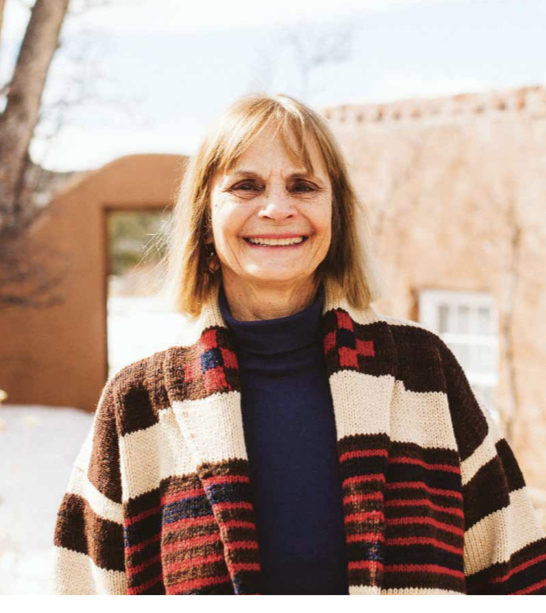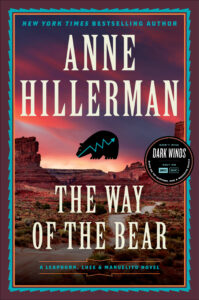
The Journal talks to best-selling Leaphorn, Chee & Manuelito novelist Anne Hillerman—the first honoree in our Icons of the West series—on how the West is written.
Written by Jenn Thornton
In 2008, after the death of western-crime writer Tony Hillerman, his daughter Anne Hillerman, a successful and ground-breaking New Mexico journalist, picked up the novelist’s pen to continue his wildly popular Leaphorn & Chee novels, keeping both his characters and his legacy alive. But she put her own stamp on the series, elevating the minor character Bernadette Manuelito to major and letting the plot thicken.
In the years since she scored the 2014 Spur Award for Best First Novel for Spider Woman’s Daughter, Anne has left a blazing paper trail of seven best-sellers, including The Way of the Bear, out this April. And, in another fascinating chapter, AMC created the western noir Dark Winds based on characters that she and her father created. It’s a story so good, it might as well be criminal. But when Anne tells it, it’s even better.
Anne, what is the value of a story to you?
Stories are my life’s blood. Stories help me make sense of the world, put the past in perspective and anticipate the future with joy. I don’t want to imagine the world without them. They are priceless.
Since this is for John Wayne Journal, script me story, but with a plot twist. If Duke were with us today, create a character and a scenario for him to play as an actor.
I would love to see a handsome, young John Wayne go to work for a Navajo family, helping them find their beautiful-but-troubled missing sister/daughter/cousin. With his never give up attitude infused in the role of this special investigator, John Wayne could certainly rescue the young woman from whatever terrible mess she’d gotten involved with, bring peace to her family, and let the bad guys know not to mess with Native. Instead, these women deserve their respect.
Talk about growing up in the West, a place you write about so vividly. What are the values that both place and your parents instilled in you?
The American West is a landscape of expansion, of possibilities, of deep human roots and connections, and simultaneously a place with a reputation for allowing people to begin anew. My parents were practical, courageous dreamers. They taught me to be brave, to enjoy life, to do my best, and that the greatest happiness comes from sharing our stories, our resources and our kindness with others.
One of the things that make your novels, and your father’s before you, so rich is their focus on real places. Talk about the role of “real-life” in your fictional stories.
Real life contributes to my fiction in many, many ways. The most obvious is in setting. I strive to place my characters in actual places on the Navajo Nation and the Four Corners area. For example, my novel that comes out this year (April 25, 2023), The Way of the Bear, uses Bears Ears National Monument and the Valley of the Gods as a primary setting. Real life events also figure into my stories. As a former journalist, I’m an avid follower of the news and read The Navajo Times and other legitimate information sources for a handle on what’s happening today in Indian Country and beyond. These true incidents sculpt my fiction and give it some timely sharp edges.
Do you miss your nonfiction days? You have a fascinating CV. Food writing, investigative journalism, technical writer. I’m curious if not writing fiction immediately had anything to do with carving out your own niche as a non-fiction writer… or was timing everything?
My decision to switch to fiction unexpectedly sprang from my non-fiction career. One of my last non-fiction projects was Tony Hillerman’s Landscape (Harper), a book of text of photos featuring the beautiful places my author-father Tony Hillerman loved the most on the Navajo Nation. To create that book, I closely re-read all of Dad’s novels with his Navajo detectives. His characters were already alive for me, and the voice of his storytelling resonated in my heart and my writer’s brain.
You’ve called your dad your hero. What made him heroic in your eyes?
Many things made him a hero to me. His wonderfully curious mind, his capacity for wonder, his generosity toward his students and other writers, his deep love and faithful devotion to my mother and to us, his children. Dad encouraged me to pursue my creative work, even though he knew from his own experience how many challenges awaited me on my own journey to become a professional writer.
When you picked up writing the Leaphorn & Chee novels, you evolved the series by making Officer Bernadette Manuelito from a minor to main character. That move makes sense. Feisty and dynamic women who can take care of themselves is the story of many women in the West. Why make her more central to the story?
When I got the idea to continue the Leaphorn series, I knew I could never be Tony Hillerman. I had to come up with something that would set my books apart from his, while still staying true to the elements in the books that Hillerman fans loved. Bernadette Manuelito had potential, I thought. I wanted Bernie to go from girlfriend to policewoman-crime solver-hero. In placing her in the center of the re-invented series, she honors a longstanding viable tradition of female leadership in the West and especially in the Navajo world.
You’ve written consecutive best-sellers and won many awards for your work. How do you measure success?
I want each book to tell a suspenseful story that entertains the reader, does justice to the heritage of the series and satisfies my itch to tell a good tale. My goal is to make each book in the series better than the one that came before. If part of the story I’m creating can bring me to tears and if I can make myself laugh, too, that’s one measure of success. With my first book, Spider Woman’s Daughter, my goal was to finish it with enough skill that my mother, Tony’s first and best editor, would give it her blessing. She did! I also consider it success at the point when a book in progress has become so compelling that I have to keep working instead of going to bed or goofing off.
When you are writing about the West, do you look at the region as a character itself?
Of course, the West is a character in my book. The landscape is alive with danger and possibilities, with beauty and challenge, with rich complexity in terms of our history, cultures, and the way we envision to future. The mountains and deserts draw some people who need this expansiveness to rev their engines. And the West, of course, includes the sacred homelands of many indigenous people, such as the Navajo, Ute, Apache, Rio Grande Pueblos, Hopi, Zuni, Paiute and others. The pioneer spirits who came west for so many different reasons all added layer on layer of intriguing complexity. While every part of the country has its charms, the light, the landscape and the people of the American Southwest provide my inspiration. This is my beloved home territory.
Dark Winds on AMC is based on the characters your father and you created. What do you make of this golden age of current Western-themed material?
I am enormously pleased with Dark Winds. The series captures the essence of the Hillerman stories on which the episodes were based while adding logical plot points and character developments. The actors who play the leading and supporting roles contribute Native American authenticity to the show. I think the newfound interest in stories of the old or modern west grow in part from the human desire to have a world where it is easier to tell the good guys from the bad guys. A time when heroes like Joe Leaphorn could win the day with brains and personal courage and integrity.
 The Way of the Bear is coming out soon. Is there another season of Dark Winds blowing out our way?
The Way of the Bear is coming out soon. Is there another season of Dark Winds blowing out our way?
I’m excited about The Way of the Bear. I believe it’s the best plotting of a mystery I’ve done yet, and it also goes deeper into the personal challenges of my two main characters. And, yes, the second season of Dark Winds finished filming in February 2023.
We know about your work, but tell me about your life today. What are your amusements, your joy? How and with whom do you spend your time?
I am blessed to have family that I love. A son, three step-children and some precious grandchildren. I love heading off to the Navajo Nation to research settings for my novels and traveling to writers’ conferences and book festivals to chat with fans and visit interesting spots while I’m traveling. After a few years of being a widow, I met a wonderful man—a writer, editor, teacher, and creative problem solver—who will become my husband in late May. He and I will have a home in Tucson as well as one in rural Santa Fe County.
When you picked up the characters your father left behind, the story was about carrying on his legacy. Now it is about you—your craft, your story. How does that feel and what’s your next chapter, Anne?
At this point, I am still enjoying moving the characters forward into new territory. At some point, Joe Leaphorn may decide to really retire—after all, he has been working hard since the 1970s. Because Bernadette Manuelito has an active mind and a deep dedication to the fundamental “protect and serve” philosophy of law enforcement, she may want a change. Bernie may desire a bigger canvas on which to apply her skills. As he enters middle age, Jim Chee is mellowing and remembering his earlier interest in a more spiritual life. And thinking it wouldn’t be bad to be a dad. I’m not sure where all these elements will lead me, but I’m up for the challenge.
Author photo by Riley Russill; The Way of the Bear cover courtesy of Harper Collins.


